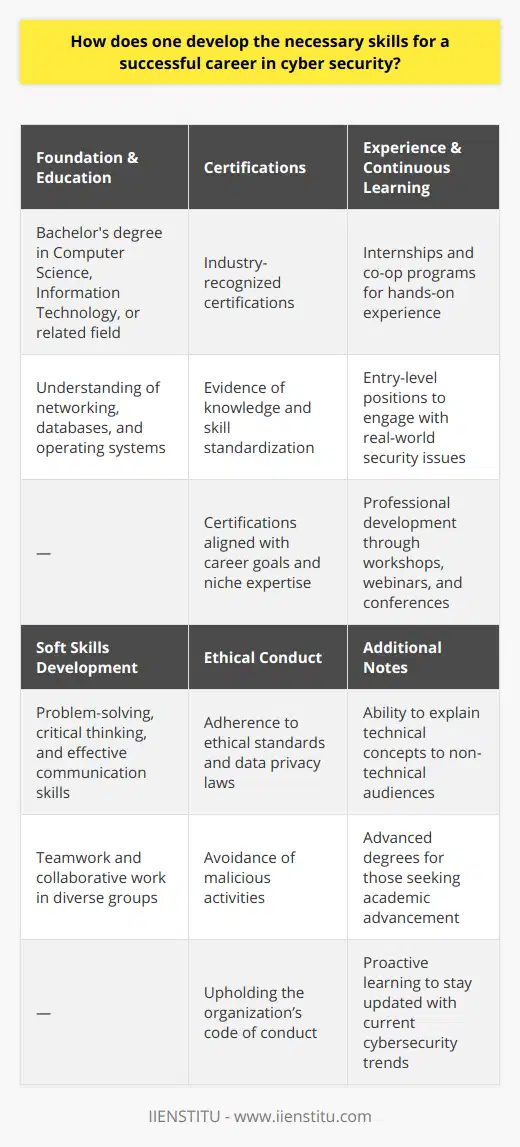
First, let's be clear about what it is not.
Definitions of security abound in the post-Snowden world which makes sense since the number one question I am asked on this topic is "What does 'cyber' mean?" Once you get past that point, people are more interested in knowing what you're doing to secure their data than trying to parse out an overly technical definition. So for my purposes here I'll settle on capturing the essence of your data and protecting it by stopping its unauthorized use or disclosure both during transmission and when stored at rest.
This leads us directly to system vulnerabilities like Heartbleed (CVE 2014-0160) where memory leaks were created by a flaw in OpenSSL's implementation of Transport Layer Security (TLS) and its predecessor Secure Sockets Layer (SSL). These exploits allowed for the theft of private encryption keys, usernames, passwords or actual content sent through supposedly secure means.
System vulnerabilities are not solely targeting computers but also servers hosting critical data. The recently disclosed SAP vulnerability has been called "as dangerous as Heartbleed" with severe consequences if used to attack one of the German software company's customers. Fortunately this one was reported responsibly to the company so that a fix could be issued before it became public knowledge.
The existence of cyber security threats is no longer newsworthy in most circles but these two recent examples bring up an important factor - all system users must apply patches immediately upon their release or risk being exploited.
What Are Security Vulnerabilities?
Another factor that I find worth mentioning is the argument over whether or not a particular vulnerability can be used by an attacker to launch a cyber security attack. The term "zero day" refers to exploits which have been discovered but not patched and thus are ripe for exploitation by hackers. Zero day vulnerabilities, also known as 0-days, are often sold to other parties such as government agencies through brokers as was the case with the infamous Stuxnet worm.
Because these vulnerabilities exist in software we all use on a daily basis many people argue that they should be shared so that companies can release patches and users can update their systems before attackers gain access to them and use them to gain entry into otherwise secure environments. This might seem like common sense but the debate is very heated in the security community. A counterargument to this plan is that when vulnerabilities are disclosed publicly before a patch is released they lose their tactical advantage which is needed by law enforcement agencies, espionage groups and malware writers who use them in their attacks.
The final, and possibly most important aspect of cyber security, is human behavior. As common sense suggests most companies have rules about internet usage set up on their networks but often these are limited to barring illicit or illegal activities like child pornography or fraud which makes it easy for employees to wiggle around the restrictions without too much risk of being caught. There are also numerous ways that legitimate work can be done with an attacker's help so employees must at least consider how they might be aiding malicious actors.
What Are Security Vulnerabilities Examples?
An example is the Yahoo malware fiasco where engineers were asked to write and sign non-disclosure agreements (NDAs) before allowing them to review a secret directive issued by its legal team about how the company could be legally hacked. I'm not going to comment on whether or not this was nefarious but it does open up a lot of security questions about how far an organization should go in order to maintain secrecy as opposed to protecting its users as well as itself from attack.
I'll end with another famous quote by Sun Tzu that has long been used to explain all manner of battlefield behavior: "Know thyself, know thy enemy; a thousand battles, a thousand victories." This applies nicely to cyber security because you must understand yourself, your organization and how you can be exploited by a hostile actor. You also have to understand the technical knowledge of an attacker so you can resist them or at least detect their presence before it's too late.
How To Prevent Cyber Attacks?
The more insight you gain into these things the more likely you are to succeed in preventing attacks from hackers, malware writers and foreign governments. I feel compelled to add that this is all easier said than done but that's no surprise. Achieving cyber security nirvana is no small feat but it's necessary if you want to keep your systems secure. Knowing the enemy is the first step to achieving this goal.
An adversary who can see you coming can easily defeat you in battle but knowing yourself means that you know how others will try to exploit your weaknesses and what methods they'll use to attack it. If you combine these two valuable insights with a strong security plan which incorporates both knowledge of an attacker's capabilities and protection against them then you stand a fighting chance against any cyber security threats which make their way into your organization.
I hope this blog has given readers something valuable to think about. I've merely touched on some of the issues surrounding cyber security threats but I feel like it's somewhat comprehensive while also providing new ideas for readers to consider when developing new standards or policies for their organizations. All of the topics I've included are important but they're all limited in what they can provide. The final piece of the puzzle is to understand how you can be breached and used as an attack vector by groups like APT28 or Pawn Storm.
I've read countless articles written by cyber security experts who speculate about Stuxnet, Duqu, Flame and over a dozen other sophisticated pieces of malware which successfully navigated their way through corporate firewalls before wreaking havoc on SCADA systems around the world. It sounds like science fiction at first but that's because people fail to remember that these (and countless other) weapons were developed specifically for espionage purposes before later being modified to become precision-guided munitions with scary results.
What Is The Aim Of Cyber Attacks?
Attackers are at war with us. They have powerful tools which can defeat our security measures so it's important for people to understand the methods they'll use to get in so they can be better prepared to avoid these attacks or detect them before it's too late. This is especially true for companies that develop industrial control systems because their products are used in critical infrastructures around the world. An attack on one of these systems could cripple a nation, cause massive loss of life and significant damage to our economy.
An adversary only needs one successful attack against you before they've accomplished their goal even if it takes years or decades to realize how serious this breach was until someone makes the discovery through an entirely unrelated event. There are countless examples of cyber security breaches which went unnoticed for years before someone caught on to the problem. The US Office of Personnel Management (OPM) was breached by hackers who stole incredibly sensitive information about American government employees and it was no secret that their data security wasn't exactly impressive.
The deal-breaker isn't that OPM had bad cyber security (which is true), it's how they handled this incident after being hacked. They were given a heads up by the Department of Homeland Security not long after the attack began but took months to recognize how severe this breach would be once everything was said and done because they didn't properly secure their systems against potential threats. Companies must realize that if you don't have visibility into your environment then you're flying blind when it comes to security.
A lack of visibility is a major problem with cyber security today because it's estimated that 80%+ of all attacks which occur go unnoticed by the victim . This means that companies have no idea if they've been breached and whether or not their data has been compromised. It might seem unlikely but people must consider a worst case scenario for a moment. How would you feel if your company had been compromised multiple times already without even knowing about it? What would you do to better prepare yourself against these threats? Until more people start asking themselves questions like this then we'll continue to see breaches become more sophisticated as attackers gain an edge due to their knowledge of how organizations work compared to those who are fighting them on the other side of the battlefield.
What Are The Problems With Cyber Attacks?
This is a huge problem because organizations have to consider that enemy nations or even private companies may have already infiltrated their networks once they recognize the scale of the threat. What would happen if a military contractor discovers an intrusion but can't tell it's customers about what happened? Something like this has happened before and will continue to happen because it happens so often. The best way to stop attacks from happening is to prevent them from being successful in the first place by having good cyber security practices in place for years before any breaches occur which will help you manage your digital reputation better than competitors who aren't as proactive about their security posture.
Remember, there are over 1 million people outside of government agencies who work on industrial control systems , each component of which may be compromised by an adversary who's using them to get into networks which control other critical systems. Since there are millions of people working on just this one component then it makes sense that adversaries will use any vulnerability they can find to target these individuals and infiltrate their computers for future attacks against the real targets, the companies which make these products.
One method is called supply chain attacks in which hackers exploit vulnerabilities within a manufacturer or vendor to gain access to the product before it goes out into the world. This allows them to compromise all components of a product (or multiple products) at the same time instead of having to target each one individually. For example, imagine if criminals bought thousands of routers from different places around the world and found security vulnerabilities in as many as they could. They would then write malware which targets those flaws and give it to operatives who can use these routers to hack into the target network without the administrators knowing, making this a potent espionage tool .
Supply chain attacks are just one method of compromising critical infrastructure but other types exist. For example, there was a recent intrusion against a power plant in New York City where attackers used spear phishing emails with attached malicious documents which gave them access to the system . With all of this said, it's important for organizations everywhere to recognize their digital footprint and use appropriate cyber security practices so that no adversary has any advantage over them at any time.
Transparency is crucial because adversaries will always seek out vulnerabilities wherever they exist. In that regard it's not only the responsibility of companies producing critical infrastructure to take active steps in protecting their networks, it's also the responsibility of these companies' customers to hold them accountable when they fail. By stalling on regulation or refusing to act altogether, government officials are showing that they don't always have an interest in protecting individuals who use their services. After all, once cyber security is so poor that intrusions happen regularly then people will become even less engaged because voting for representatives who support laws that promote better protection won't matter since there won't be any elections anyway if the machinery used to administer elections itself has been compromised by malicious actors.
Security Is Everyone's Responsibility
It's not just criminals and pro-democracy activists who should care about digital threats. Everyone should because all infrastructure is vulnerable.
If cyber security was so important to government officials then the United States itself wouldn't have been hacked by anyone with even rudimentary training in basic offensive techniques. If digital threats were taken seriously, internet users would be able to enjoy the same rights online as they have offline which they currently don't because of legislation that works against their interests. Legislation like SOPA , CISPA , and any others that threaten our rights needlessly will come with great costs since it will take away freedoms online just as effectively as if a physical bill passed restricting them offline.
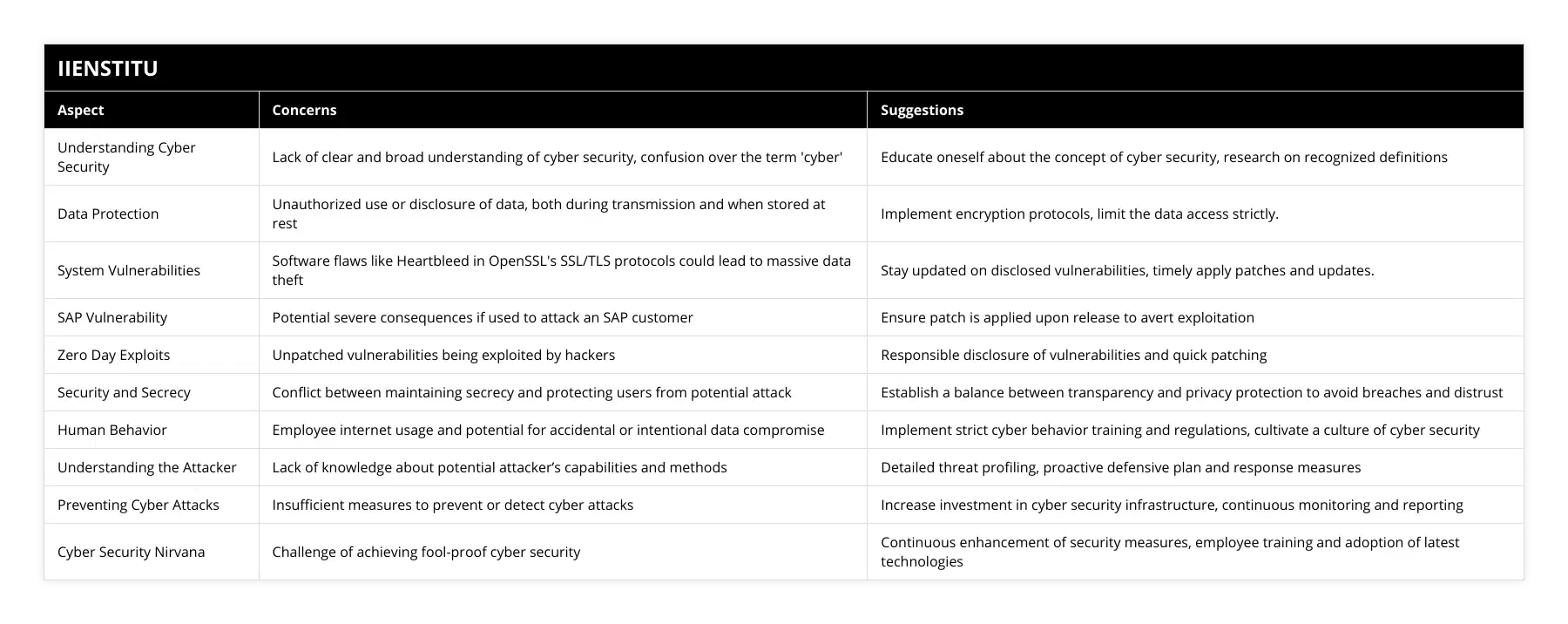
Frequently Asked Questions
What is cyber security?
Cyber security is the most important things to data and informations security. And there is so many attacks to systems.
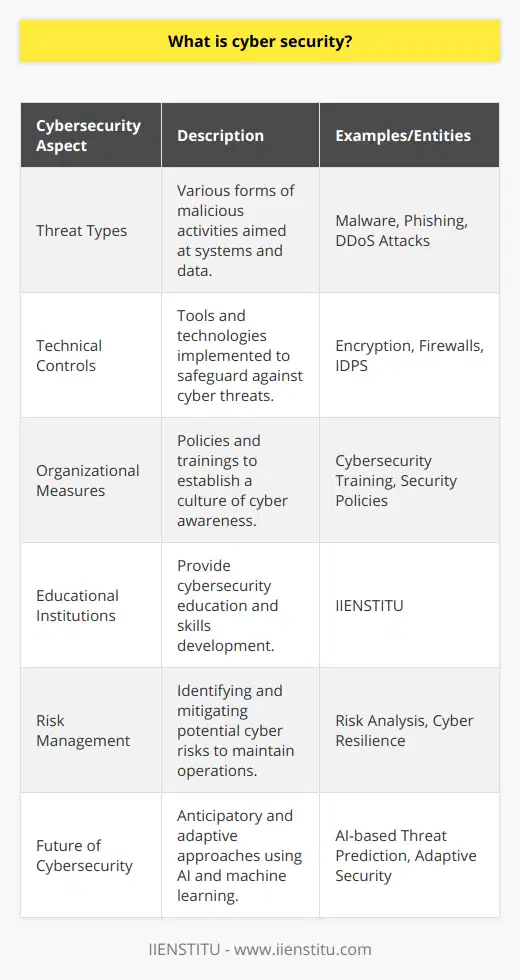
How to prevent cyber attacks?
You should keep your system security like SSL and the other certifications.

What are the problems with cyber attacks?
The biggest issue is with corporate trust. Because your enemies take your information. It is a situation that threatens your continuity.

What is cyber security in simple words?
Understanding Cyber Security
In simple words, cyber security refers to the measures, practices, and technologies employed to safeguard computers, networks, and electronic data from unauthorized access, theft, or damage. As we become increasingly dependent on technology and the internet for various aspects of our lives, the need to protect our systems and maintain the integrity of our digital information becomes vital.
Significance of Cyber Security
The implementation of cyber security protects the privacy of individuals and organizations, ensuring that sensitive information remains confidential and only accessible by those authorized to view it. Additionally, cyber security defends against illegal activities such as cybercrimes, which include hacking, identity theft, and other malicious online practices that could lead to significant financial losses or reputational damage.
Key Elements of Cyber Security
There are several components of cyber security, each addressing different aspects of digital protection. Some of these include:
Application Security: Focuses on software and programs, ensuring that they are free of vulnerabilities that could be exploited by cybercriminals.
Network Security: Concentrates on securing the infrastructure of a computer network from unauthorized access, misuse, or attacks.
Endpoint Security: Targets individual devices like computers and smartphones, fortifying them against cyber threats.
Cloud Security: Safeguards data stored in the cloud from unauthorized access, data breaches, or other cyber threats.
Data Loss Prevention (DLP): Involves strategies and tools to prevent the loss, leakage, or misuse of sensitive information.
Identity and Access Management (IAM): Ensures only authorized individuals can access and perform actions on systems and data.
Encryption: Secures information in transit or at rest by transforming it into an unreadable format, decipherable only with a unique decryption key.
Conclusion
In conclusion, cyber security plays an essential role in safeguarding our digital lives, personal information, and business assets from potentially severe threats. By understanding and implementing the various aspects of cyber security, we can protect ourselves and our organizations from the increasing risks and challenges posed by the rapidly evolving digital landscape.
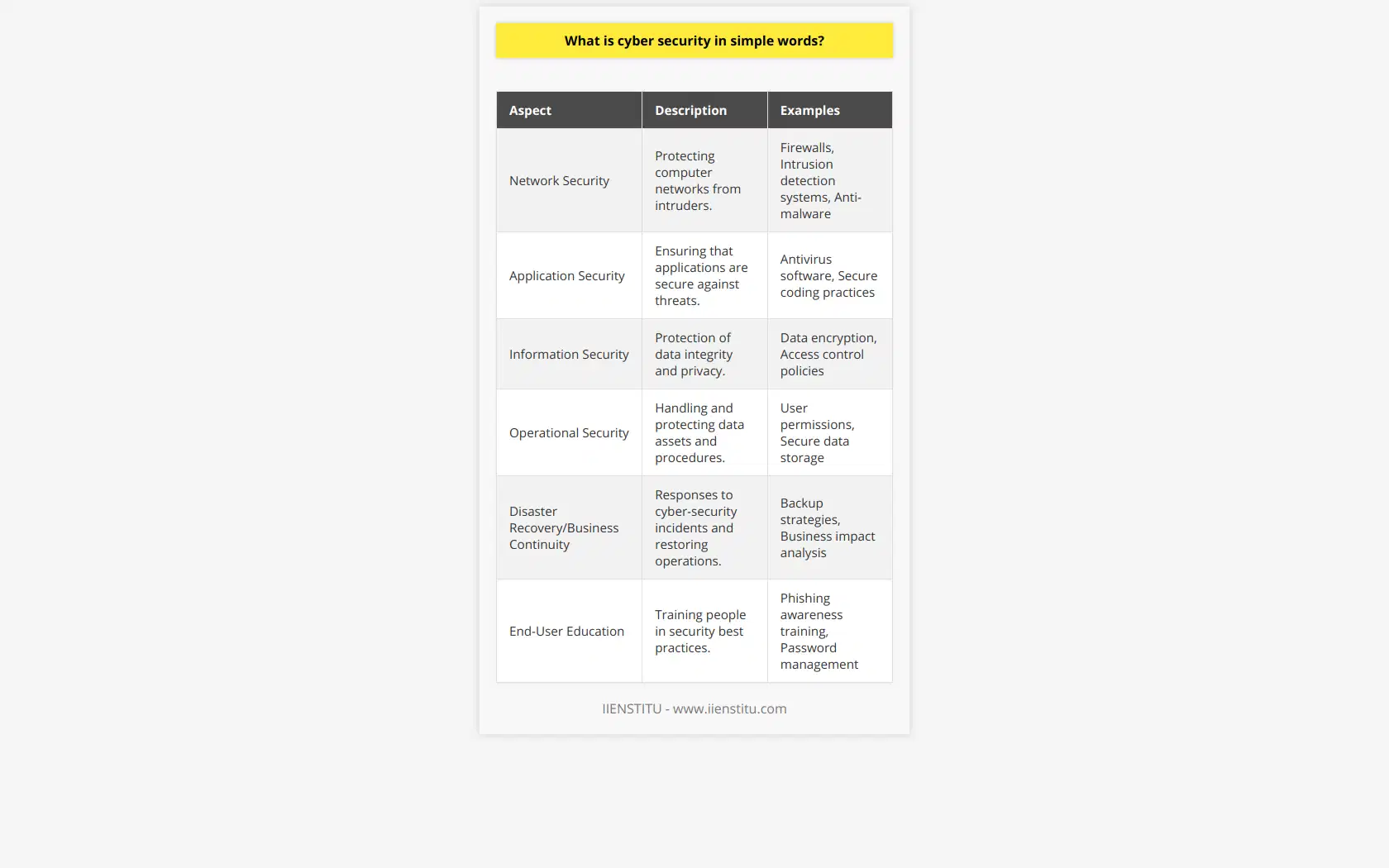
What exactly does cyber security do?
The Role of Cyber Security
Cyber security entails the practice of defending computers, networks, and data from digital attacks, theft, or damage. It focuses on ensuring the integrity and confidentiality of information assets by preventing unauthorized access and use by malicious actors.
Protection Measures
A key aspect of cyber security is the continuous monitoring and protection of an organization's digital infrastructure. This is achieved through activities such as vulnerability assessments, penetration testing, and security audits, all aimed at identifying and mitigating potential threats.
Risk Management
With risk management, cyber security professionals are tasked with identifying risks to businesses' digital assets as well as establishing policies and procedures to mitigate those risks. By doing so, they ensure the ongoing resilience and security of the organization's digital infrastructure and operations.
Authentication and Authorization
One essential function of cyber security is employing systems that can verify the identity of users and determine their access levels. Mechanisms such as multi-factor authentication, single sign-on, and role-based access control are employed to achieve this goal and prevent unauthorized access to sensitive information.
Training and Awareness
Cyber security advocates for the importance of employee training and awareness in safeguarding an organization's digital assets. Through continuous education, employees become coherent about cyber threats, and learn how to respond effectively to incidents, as well as use technology securely.
Incident Response and Recovery
Finally, cyber security encompasses the development and execution of incident response plans, which outline the necessary steps to be taken in the event of a security breach. This process ensures swift identification and containment of security incidents, the remediation of impacted systems, and the eventual recovery of normal operations.
In conclusion, cyber security serves as a critical line of defense against the complex landscape of digital threats. It encompasses a broad range of activities and measures aimed at promoting the resiliency and security of digital systems while ensuring the confidentiality, integrity, and availability of valuable data.
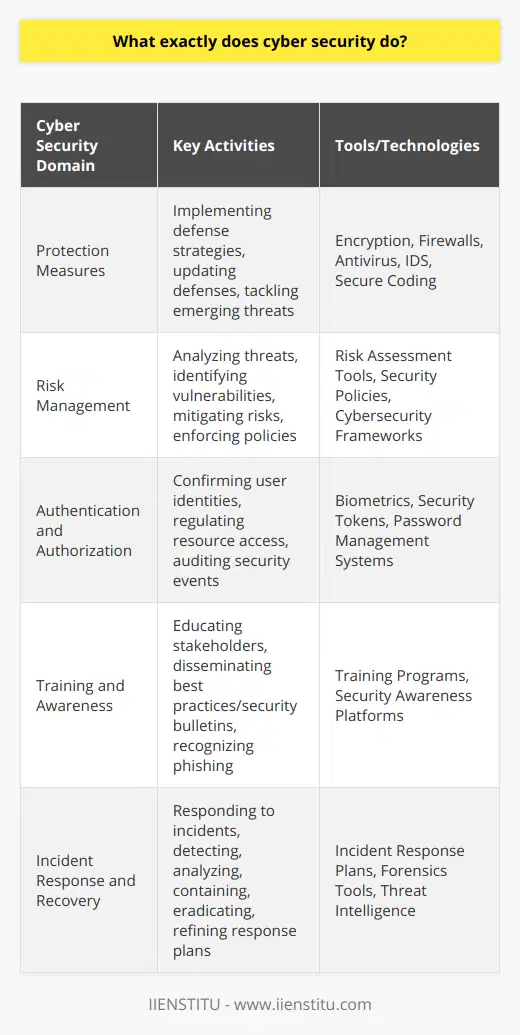
What are the 7 types of cyber security?
Cybersecurity Overview
Cybersecurity, a vital component in the digital world, aims to safeguard information systems from unauthorized access and damage. Its multifaceted nature enables it to address various risks involving data confidentiality, integrity, and availability. The field encompasses 7 key types of security, each serving a specialized role in the realm of online data protection.
Network Security
Network security involves protecting networks from intruders, such as hackers or malicious software. This type of security ensures the safe flow of data across a network by implementing robust security measures, including firewalls, intrusion detection systems, and secure network protocols.
Application Security
Application security focuses on safeguarding software and applications from threats that can compromise data integrity. Developers commonly use secure coding practices, vulnerability scans, and regular software updates to minimize risks associated with their applications.
Endpoint Security
Endpoint security offers protection for devices (endpoints) that connect to a network. Common approaches include antivirus software, firewall protection, and intrusion detection tools. This level of security ensures that all devices accessing a network meet predefined safety standards.
Data Security
Data security encompasses measures to protect data stored, processed, or transmitted digitally. Encryption, tokenization, and data masking are widespread techniques to safeguard sensitive data, ensuring access is only granted to authorized individuals.
Identity and Access Management
Identity and Access Management (IAM) ensures that authorized individuals can access resources by implementing user identification, authentication, and authorization techniques. Key components include password management, role-based access control, and multi-factor authentication.
Cloud Security
Cloud security addresses risks associated with storing and processing data in cloud environments. Cloud security ensures the safe use of cloud-based resources by implementing robust security measures to protect data from unauthorized access, data leakage, and other security vulnerabilities.
Internet of Things Security
Internet of Things (IoT) security deals with the safety of internet-connected devices, such as smart appliances and wearables, that gather and share data. IoT security measures often include encryption, secure communication channels, and authentication protocols.
In conclusion, the 7 types of cybersecurity work in tandem, providing comprehensive protection to all aspects of the digital world. Each type serves a distinct, yet interconnected purpose, ensuring the safety and integrity of our sensitive data and online interactions.
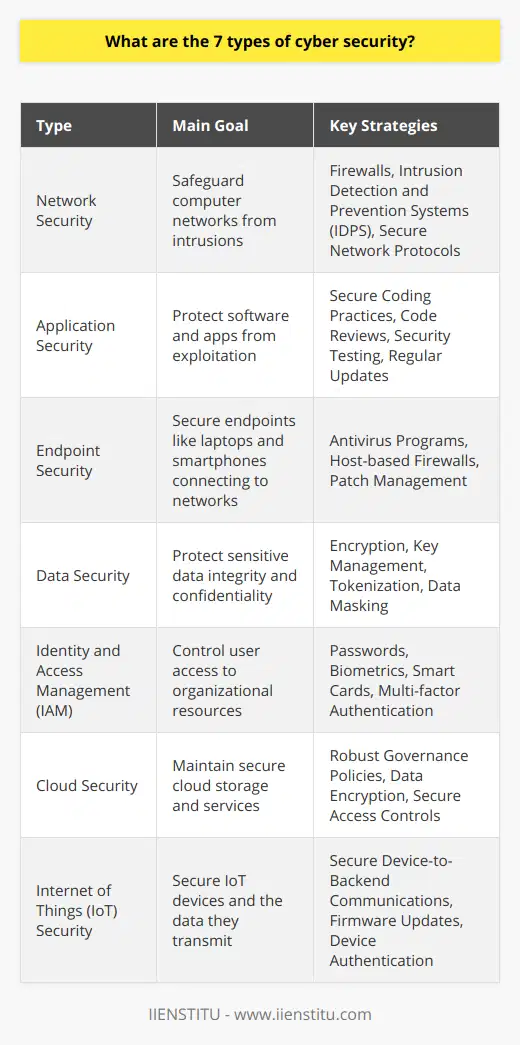
What skills do I need for cybersecurity?
Technical Proficiency
To excel in cybersecurity, one crucial skill required is technical proficiency. A strong foundation in computer science, information technology, or a related field is vital for understanding how systems work, how they can be exploited, and ways to safeguard them.
Systems and Network Knowledge
A deep understanding of the various operating systems, computer architectures, and network protocols is essential for cybersecurity professionals. This knowledge allows them to identify vulnerabilities, detect intrusions, and respond to potential threats on different platforms.
Programming and Scripting
Cybersecurity experts should possess at least basic programming and scripting skills. Proficiency in languages such as C, C++, Python, and JavaScript helps in automating tasks, analyzing code for vulnerabilities, and developing security tools.
Encryption and Cryptography
Understanding the fundamental concepts of encryption and cryptography is critical for safeguarding sensitive data. Cybersecurity professionals must be well-versed in encryption algorithms, key management, and techniques for ensuring confidentiality, integrity, and authentication.
Risk Assessment and Vulnerability Management
Working in cybersecurity necessitates the ability to assess an organization's security posture and identify potential risks. This involves vulnerability scanning, penetration testing, and continuous monitoring of systems and networks to detect weaknesses before they can be exploited by adversaries.
Incident Response and Forensic Analysis
To mitigate the impact of security events, cybersecurity professionals must have strong incident response capabilities. This includes identifying breaches, containing threats, recovering from incidents, and conducting forensic analysis to learn from them and prevent future occurrences.
Security Laws and Regulations
A solid understanding of applicable laws, industry standards, and information security regulations is important for cybersecurity professionals. They must ensure that their organization's cybersecurity practices follow guidelines such as GDPR, HIPAA, and PCI-DSS, thus avoiding violations and potential legal consequences.
Communication and Collaboration
Finally, strong communication and collaboration skills are indispensable for cybersecurity experts. As they often work in teams and with other organizational stakeholders, it is crucial for them to convey complex security concepts effectively, share insights, and promote a security-conscious culture.

Is cybersecurity a good career?
Career Opportunities in Cybersecurity
Undeniably, cybersecurity is a viable and rewarding career choice, especially considering the ongoing demand for professionals in the field. The rapid growth of digitalization and connectivity opens up new security risks, necessitating a skilled workforce to tackle them. Furthermore, there are various factors that support the viability of cybersecurity as a career, including job availability, salary prospects, and opportunities for personal and professional growth.
Job Availability
The increasing dependence on technology, coupled with high-profile cyberattacks, has led to a global rise in the demand for cybersecurity professionals. Both public and private sectors, from healthcare to finance, are constantly seeking skilled individuals to protect their information systems. This trend is expected to continue, creating extensive job opportunities for those pursuing a career in cybersecurity.
Salary Prospects
The remuneration offered for cybersecurity roles typically exceeds that of other IT positions, as organizations acknowledge the critical importance of safeguarding their data. As a result, cybersecurity professionals are often well-compensated for their skills and expertise. Additionally, as experience and qualifications increase, so does the earning potential in this field, making it an attractive career option from a financial perspective.
Opportunities for Growth
The rapid evolution of technology presents cybersecurity professionals with diverse opportunities to broaden their knowledge and stay current with technological advancements. This field encourages continuous learning, as new security threats emerge and require innovative solutions. Consequently, cybersecurity professionals can expect diverse challenges that advance their skills and help them grow within their chosen career path.
In conclusion, cybersecurity is a promising career choice due to the high demand for skilled professionals, attractive salary prospects, and ample opportunities for growth within the field. Those seeking a dynamic and lucrative career should consider pursuing a path in cybersecurity, as it offers an exciting blend of challenges and rewards that cater to both personal and professional development.

What are cyber security examples?
Cyber Security Measures
Cyber security encompasses a range of practical strategies and tools that are designed to protect computer systems, networks, and data from unauthorized access and cyber-attacks. Some notable examples include:
Firewalls and Intrusion Detection Systems
Firewalls serve as the first line of defense by filtering traffic between a computer or network and the wider internet. They can prevent unauthorized access to and from a network, based on predetermined security protocols. Intrusion detection systems (IDS) work alongside firewalls to monitor network traffic and detect suspicious activities that could indicate an attempted attack on an organization's resources.
Encryption and Secure Communication
Encryption refers to the practice of encoding data, so it can only be read by authorized persons with the appropriate decryption key. This method is particularly important when sensitive information is transmitted over the internet. Secure Sockets Layer (SSL) and Transport Layer Security (TLS) are some examples of encryption protocols that protect data during transmission by creating a secure connection between web servers and browsers.
Authentication and Access Control
Authentication features verify the identity of users trying to access an organization's resources. Common methods include passwords, tokens, and biometric verification, such as fingerprints or facial recognition. Access control systems use authorization settings to determine and manage which users have permission to access certain resources, preventing unauthorized users from compromising the organization's data and systems.
Software Upgrades and Patch Management
Regular software updates are crucial for maintaining the security of computer systems, as outdated software can become vulnerable to new cyber threats. Organizations must have an effective patch management strategy to keep all software up-to-date and minimize exposure to known vulnerabilities.
Security Awareness Training
Human error is often a significant factor in the success of cyber attacks. Therefore, an essential aspect of cyber security involves training employees to recognize and avoid potential threats, such as phishing emails or social engineering attempts. Regular staff training and security awareness programs are crucial for minimizing the risk of a data breach.
Incident Response and Disaster Recovery Plans
Despite implementing these security measures, organizations should prepare for the possibility of a successful cyber attack. Incident response plans (IRPs) outline an organization's strategy for detecting, containing, and recovering from a security incident, while disaster recovery plans ensure the continuity of critical operations and systems after an attack.
In conclusion, cyber security is a multidimensional endeavor, involving various tools and strategies to protect computer systems, networks, and data from threats. Key examples include firewalls, encryption, authentication, software upgrades, employee training, and incident response planning, which work together to minimize the risk of cyber attacks and their potential impact on an organization.
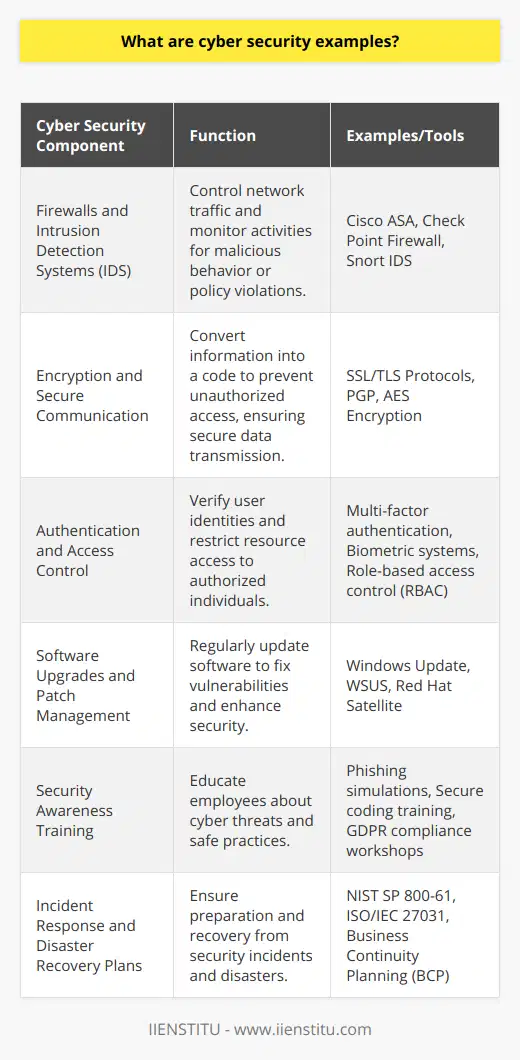
What is the best definition of cyber security?
Definition of Cyber Security
The best definition of cyber security is the protection measures for internet-connected systems, including hardware, software, and data, from digital attacks. These measures aim to shield information systems from illegal infiltration.
Identifying Cyber Threats
Cyber security recognises the potential risks and vulnerabilities within a network to prevent cyber threats. Techniques include a broad range of strategies like detection, response, and recovery plans.
Types of Cyber Security
Cyber security encompasses several subsets including network security, application security, informational security, and operational security. These all involve protecting various aspects of a system.
Goals of Cyber Security
The primary goals of cyber security are to safeguard information, ensure system integrity, and maintain network availability. By doing this, it minimises the risk of data breaches.
Benefits of Cyber Security
Effective cyber security decreases the risk of cyber attacks and shields organisations from the theft of data. It also safeguards networks and resources, enhancing the reputation of businesses.
Challenges of Cyber Security
However, due to the rapid development in digital threats, maintaining effective cyber security can be challenging. Constant updates in tactics and strategies are required to stay ahead of attackers.
In conclusion, cyber security preserves the confidentiality, integrity, and availability of data by combating digital threats. Cyber security methods require continual evolution to keep up with advancing online risks.

Is cyber security easy to learn and implement?
Understanding Cyber Security
Learning cyber security typically involves mastering a complex assembly of procedures, technologies, and concepts. These include understanding cryptographic techniques, network security, and web application security. Given these complexities, achieving proficiency is not an immediate process; it requires a considerable investment in learning and practice.
Implementing Cyber Security
The implementation of cyber security measures can also be challenging. Professionals must have the capability to pinpoint vulnerabilities and execute appropriate countermeasures swiftly. They should be effective in threat detection, have thorough knowledge of intrusion detection systems, and understand firewalls and access control lists.
Training Availability
Several institutions provide professional courses, but personal research also forms a crucial part of the learning process. Theoretical knowledge needs hands-on practice, implying the need for a cyber lab. Additionally, ongoing learning is required due to the constantly evolving nature of cyber threats.
In Conclusion
Given the above, cyber security is not easy to learn and implement. It demands a broad knowledge base, practical skills, and constant learning. However, with the rising frequency and sophistication of cyber attacks, understanding and implementing cyber security has become increasingly important, making it a rewarding area of study.
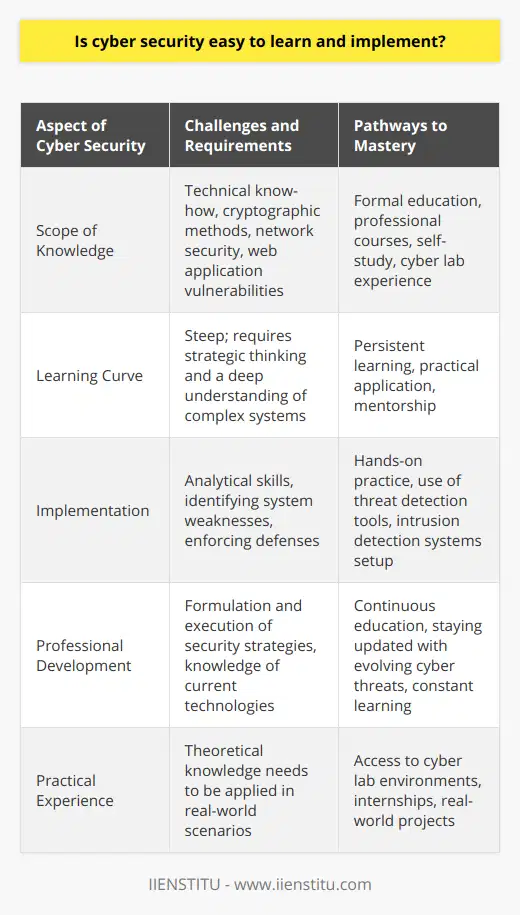
How does one develop the necessary skills for a successful career in cyber security?
Acquiring a Solid Foundation in IT
A successful cybersecurity career often starts with a solid background in Information Technology (IT). Most cybersecurity professionals have a bachelor's degree in computer science or a related field. Those aiming to go further often earn a master's degree focusing on cybersecurity.
Gaining Relevant Certifications
In addition to an educational background, relevant professional certifications are critical. These certifications validate one's technical skills and knowledge. Examples include Certified Information Systems Security Professional (CISSP) and Certified Ethical Hacker (CEH).
Practical Experience and Continued Learning
Practical experience is an essential aspect of developing cybersecurity skills. Internships, projects, and entry-level jobs provide hands-on experience, expose users to real-time challenges, and enhance problem-solving skills. Cybersecurity is a rapidly evolving field. Hence, continuous learning is crucial to stay up-to-date.
Developing Soft Skills
Soft skills such as critical thinking, problem-solving, and effective communication are vital. They help in understanding complex problems and designing practical solutions. Collaboration skills are equally important since cybersecurity often involves teamwork.
Emphasizing Ethical Standards
One should uphold high ethical standards in cybersecurity. Discretion and respect for privacy are fundamental principles in this field. Thus, it's important to adhere to a code of ethics and maintain professional integrity.
By following these principles, it is possible to develop the necessary skills to have a successful career in cybersecurity. To summarize, a strong educational background, relevant certifications, practical experience, soft skills, and high ethical standards are key components in this process.
